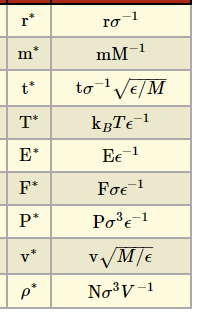Dear all
I have some questions about unit conversions in LAMMPS. That is, how to convert units Lj into real units. I have read the manual, which mentions reduced units, setting sigma, Epsilon, Mass, Boltzmann constants to 1. I don’t understand how to convert according to the formula in the manual

For example, in units Lj, if the volume size of the block is 30*30*30, I understand that it is a reduced length. When calculating the stress, I take Voronoi volume weighted average of the atomic stress to obtain the instantaneous stress of the system. I understand that this is also a reduced value, but how do I convert it to the units we use commonly, such as Pa and bar?
In addition, in the system, if I use the fix NVT temp temp command, is the temperature in the system also converted to reduced temperature?
If I find a self-consistent conversion of units, I can simply add units to the calculated value. For example, I have seen others take one (r~nm, m~kg, T ~ps, E~KJ*mol-1).
If you want results in real units, why not do the simulation in real units right away?
What would be the benefit of using reduced units?
To convert LJ units into real units, you have to set the value for epsilon, sigma, and m (for instance if you have a gas of LJ atom, you can choose the epsilon, sigma, and m values of argon gas), and only then you can convert all the quantities (pressure, time, etc.) into real units.
However, as Axel said, if you are interested in real units, using Lennard Jones units just makes your life more complicated.
Dear Axel
I understand what you mean, but when I use MDPD method for mesoscopic scale simulation (um nm), I think it is appropriate to use LJ units because it is easy to convert to different units, rather than need to change in files. So I want to make sense of reduced units.
Best wishes
Dear Simon
As I replied to Alex, when I use MDPD method for mesoscopic scale simulation (um nm), I think it is appropriate to use LJ units because it is easy to convert to different units, rather than need to change in files. So I want to make sense of reduced units.
Best wishes
You are contradicting yourself here. If it was so easy, you would not ask about it.
Moreover, converting to other units is essentially the same effort for any unit set. The most succinct approach is via SI units. In LJ units the “basic units” are the parameters for the “reference element/type”, i.e epsilon (-> energy), sigma (-> length), mass and all other units (e.g. that of time) can be computed from that (e.g. via 1 J = 1 kg*m^2*s^-2 you can get your time unit from energy, length and mass). The rest is simply an exercise in (careful) application of calculus and basic physics.
